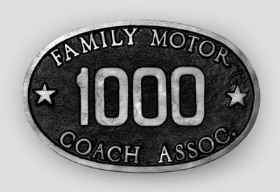In the premier issue of Family Motor Coaching, FMCA’s first president, Bob Richter, L1, addressed two questions. Why use membership numbers? And why put those numbers on identification plates that are attached to motorhomes?
Mr. Richter’s article was titled “Number, Numbers, and More Numbers!” He began by acknowledging that assigning people numbers could appear to be an impersonal way of welcoming new members. But he explained that the “dratted number system” is a necessity, and unavoidable.
“A number system makes this continuous flow of work much easier, truthfully; F345 is much easier to say than Washington, George H., and if FMCA ever grows in size to ten or twenty thousand members, or to a hundred thousand, we’d have to go back and assign numbers anyway to feed a computer, in order to continue operating. So we gave in early!”
Mr. Richter spent the rest of his column explaining the reasons behind the use of the oval (“goose-egg” shaped) metal plates that members received upon joining the association. And the reasons for their existence are more than you might guess.
First of all, fellow FMCA members would know you were also part of the family. If you met another motorhomer with a plate on his or her coach while traveling, you could, perhaps, also meet a new friend.
It was also thought that the plates made FMCA seem like a better-than-average group to those who might extend overnight parking privileges. The noble goose egg would symbolize high standards of RVer behavior.
Similarly, the plates were intended to serve as a way to advertise the existence of FMCA to the public.
FMCA used removable metal plates and not stickers or painted identification numbers for a reason: to aid in accurate identification. Mr. Richter was from Massachusetts, and he’d heard that the Massachusetts Beach Buggy Association (MBBA) asked its members to paint numbers on their buggies. “However, nothing was provided to assure that the number was painted out when the vehicle was sold,” he wrote.
One day an MBBA beach buggy was seen being operated in an improper manner, so the entire MBBA was barred from the use of that particular beach. Eventually, it was found out that the vehicle had been previously sold and was used by non-MBBA members during the incident, but the damage had been done.
Because the FMCA plates were to symbolize high standards, “It is the intention of the FMCA to control the privilege of displaying these plates strictly, so that the display of them will be meaningful.” As a consequence, the plates remained the property of FMCA the entire time they were affixed on a coach. In the early years, when a membership terminated, those heavy metal plates, both of them, had to be mailed back to the national office. Conversely, if former members rejoined, their old plates were returned to them.
“And the last, but perhaps not least, purpose of plates is to serve as means of enforcement of the code of ethics,” Mr. Richter wrote. He went on to say that if a particular member was witnessed behaving improperly (dumping in an unapproved location, for example), they could be “subject to the procedure for expulsion from FMCA.”
That’s quite a lot of meaning attached to a “goose egg” — right from the start!

